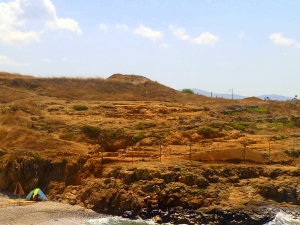The archaeological site at hill Kefali of St. Anthony or Kremasma is situated next to the sea, between the beaches Avlaki and Boufos. This point offers very good view of the canyon Selinari, which was the passage to East Crete. The excavations began in 1960 by the archaeologist Kostas Davaras and continued long after by the School of Archaeology of Belgium.
The historic Monastery of Odigitrias on the way to Agiofaraggo hides many treasures. Beyond the monastery itself with such great history and the tower of Xopateras, it conceals another surprise north of the monastery. This is the prepalatial necropolis of Odigitria, named after the monastery, as we still don’t know the name of the town it belonged to.
The ruins of the largest Minoan cemetery in Crete have been discovered in this area with 252 graves from the early Minoan period, 1800 vases and many artefacts buried with the dead.
A particular Minoan farmhouse of elliptical shape has been found at position Souvloto Mouri, near Chamezi village. The farmhouse was excavated in 1902 by Xanthoudidis and its shape has been studied by archaeologists.
On the rocky hill Papouri, located northeast of the beach of Tripiti, high above the tavern, we meet the remains of a Minoan settlement. The first excavations were made in 1986-88 by archeologist Antonis Vasilakis. A vaulted tomb of 2800-2000BC was also been found 200m on the south.
The prepalatial cemetery Koumasa is located between Loukia and Koumasa. This Minoan archaeological site was first excavated by Stephanos Xanthoudides from 1904-1906 and four graves came to light (three vaulted graves and one rectangular).
At position Platyskinos near Achladia, Sitia, a large underground vaulted tomb of diameter 4.08m, height 4.16m and corridor 9m, has been revealed. The tomb, extremely rare especially in Eastern Crete, dates back from 1400-1220 BC and is thought to have been inspired by the tombs of Mycenae.
Just next to the small village of Fylaki at Apokoronas province, Chania, you will find the vaulted tomb of Fylaki. It was built in the post Minoan Times. It is very well preserved and clean. There is a long aisle at its entrance and its pyramid-like roof is very impressive.





















































































